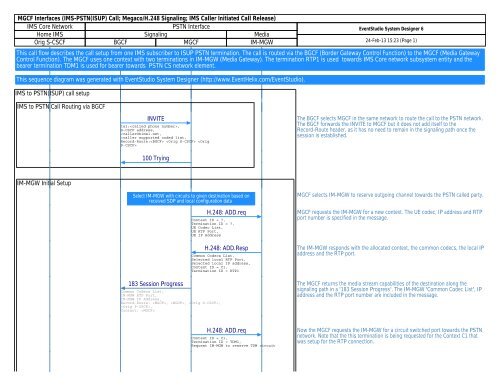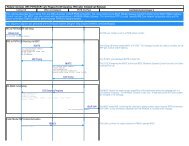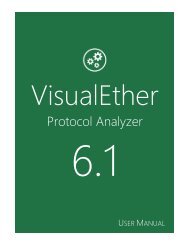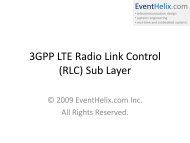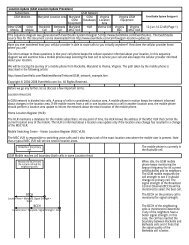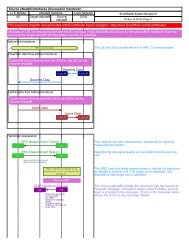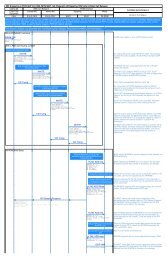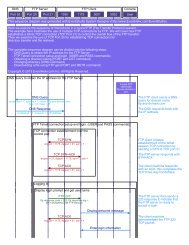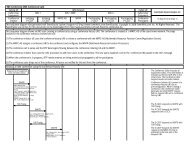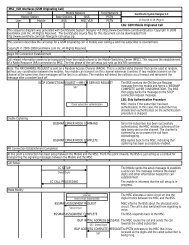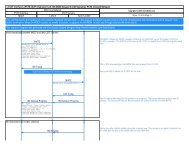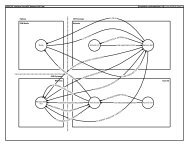MGCF Call Flow - EventHelix.com
MGCF Call Flow - EventHelix.com
MGCF Call Flow - EventHelix.com
Create successful ePaper yourself
Turn your PDF publications into a flip-book with our unique Google optimized e-Paper software.
<strong>MGCF</strong> Interfaces (IMS-PSTN(ISUP) <strong>Call</strong>; Megaco/H.248 Signaling; IMS <strong>Call</strong>er Initiated <strong>Call</strong> Release)IMS Core NetworkPSTN InterfaceHome IMS Signaling MediaOrig S-CSCF BGCF <strong>MGCF</strong> IM-MGWH.248: ADD.respContext ID = C1,Termination ID = TDM1ISUP IAMtel:EventStudio System Designer 624-Feb-13 15:23 (Page 2)IM-MGW responds with the circuit switched termination TDM1.The <strong>MGCF</strong> sends IAM, containing the called party phone number digits, towardsPSTN termination. The TDM-1 circuit information obtained from the IM-MGW isincluded in the message.<strong>Call</strong>er Media PDP Context ActivationSelected CodecPRACKThe <strong>Call</strong>er confirms the codec selection in PRACK towards <strong>MGCF</strong>.H.248: MOD.reqContext = C1,Termination = RTP1,Selected CodecH.248: MOD.respContext = C1,Termination = RTP1The <strong>MGCF</strong> modifies the IM-MGW context to update the IM-MGW about the codecselected for the RTP session.IM-MGW responds back.Selected Codec,Selected UDP Port,Selected IP Address200 OK (PRACK)The codec selected is acknowledged to the UE.UPDATESince caller PDP Context Activation is over, notify the called end in UPDATEmessage.200 OK (UPDATE) The called end replies back with 200 OK.ISUP COTBased on the continuity support of the outgoing channel selected <strong>MGCF</strong> sends aCOT message to the PSTN network.RingingISUP ACMThe path towards the called party is allocated in the PSTN network and address<strong>com</strong>plete message, ACM containing subscriber free indication is sent to <strong>MGCF</strong>. TheACM message also indicates that the called party in the PSTN network is beingalerted.180 Ringing The <strong>MGCF</strong> forwards called party alerting indication in 180 ringing message towardsthe <strong>Call</strong>er.
<strong>MGCF</strong> Interfaces (IMS-PSTN(ISUP) <strong>Call</strong>; Megaco/H.248 Signaling; IMS <strong>Call</strong>er Initiated <strong>Call</strong> Release)IMS Core NetworkPSTN InterfaceHome IMS Signaling MediaOrig S-CSCF BGCF <strong>MGCF</strong> IM-MGWPRACKEventStudio System Designer 624-Feb-13 15:23 (Page 3)The <strong>Call</strong>er acknowledges the 180 ringing with PRACK message towards <strong>MGCF</strong>.200 OK (PRACK) The <strong>MGCF</strong> acknowledges the PRACK message with 200 OK message.Conversation ModeISUP ANMH.248: MOD.reqContext ID = C1,Termination ID = RTP1When the called party answers, the terminating PSTN network sends answer, ANMmessage towards <strong>MGCF</strong>.Request a bidirectional through connectionH.248: MOD.respContext ID = C1,Termination ID = RTP1H.248: MOD.reqContext ID = C1,Termination ID = TDM1Request activation of TDM voice processing function.H.248: MOD.respContext ID = C1,Termination ID = TDM1200 OK (INVITE) The final response, 200 OK, is sent by the <strong>MGCF</strong> over the signaling path when thesubscriber has accepted the in<strong>com</strong>ing session attempt.ACKThe <strong>Call</strong>er sends the final acknowledgement in ACK message towards <strong>MGCF</strong>.BYEThe <strong>Call</strong>er sends BYE towards <strong>MGCF</strong> when the calling party hangs up.200 OK (BYE) The <strong>MGCF</strong> acknowledges with 200 OK message towards <strong>Call</strong>er.ISUP RELThe <strong>MGCF</strong> initiates call release in the PSTN network by sending ISUP REL message.Release IMS Termination<strong>MGCF</strong> requests IM-MGW to release RTP1 resource.
<strong>MGCF</strong> Interfaces (IMS-PSTN(ISUP) <strong>Call</strong>; Megaco/H.248 Signaling; IMS <strong>Call</strong>er Initiated <strong>Call</strong> Release)IMS Core NetworkPSTN InterfaceHome IMS Signaling MediaOrig S-CSCF BGCF <strong>MGCF</strong> IM-MGWH.248: SUB.reqContext ID = C1,Termination ID = RTP1EventStudio System Designer 624-Feb-13 15:23 (Page 4)H.248: SUB.respContext ID = C1,Termination ID = RTP1Release TDM Termination<strong>MGCF</strong> requests IM-MGW to release TDM1 resource.H.248: SUB.reqContext ID = C1,Termination ID = TDM1H.248: SUB.respContext ID = C1,Termination ID = TDM1ISUP RLCThis sequence diagram was generated with EventStudio System Designer (http://www.<strong>EventHelix</strong>.<strong>com</strong>/EventStudio).The PSTN network acknowledges the call release with ISUP RLC, release <strong>com</strong>pletetowards <strong>MGCF</strong>.
<strong>MGCF</strong> Interfaces (<strong>Call</strong>ed PSTN Subscriber Initiates Release)IMS Core NetworkPSTN InterfaceHome IMS Signaling MediaOrig S-CSCF BGCF <strong>MGCF</strong> IM-MGWEventStudio System Designer 624-Feb-13 15:23 (Page 5)This call flow describes the call setup from one IMS subscriber to ISUP PSTN termination. The call is routed via the BGCF (Border Gateway Control Function) to the <strong>MGCF</strong> (Media GatewayControl Function). The <strong>MGCF</strong> uses one context with two terminations in IM-MGW (Media Gateway). The termination RTP1 is used towards IMS Core network subsystem entity and thebearer termination TDM1 is used for bearer towards PSTN CS network element.This sequence diagram was generated with EventStudio System Designer (http://www.<strong>EventHelix</strong>.<strong>com</strong>/EventStudio).IMS to PSTN(ISUP) call setupBYEISUP RELThe call release initiated in the PSTN network is received by <strong>MGCF</strong> is ISUP RELmessage.The <strong>MGCF</strong> responds with call release by sending BYE message towards the <strong>Call</strong>er.Release IMS Termination<strong>MGCF</strong> requests IM-MGW to release RTP1 resource.H.248: SUB.reqContext ID = C1,Termination ID = RTP1H.248: SUB.respContext ID = C1,Termination ID = RTP1Release TDM Termination<strong>MGCF</strong> requests IM-MGW to release TDM1 resource.H.248: SUB.reqContext ID = C1,Termination ID = TDM1H.248: SUB.respContext ID = C1,Termination ID = TDM1ISUP RLCAfter performing RTP1 and TDM1 resource release, <strong>MGCF</strong> sends release <strong>com</strong>pletemessage, ISUP RLC towards the PSTN network.200 OK (BYE) The <strong>Call</strong>er acknowledges the BYE by sending 200 OK towards <strong>MGCF</strong>.This sequence diagram was generated with EventStudio System Designer (http://www.<strong>EventHelix</strong>.<strong>com</strong>/EventStudio).
<strong>MGCF</strong> Interfaces (IMS Network Initiates <strong>Call</strong> Release)IMS Core NetworkPSTN InterfaceHome IMS Signaling MediaOrig S-CSCF BGCF <strong>MGCF</strong> IM-MGWEventStudio System Designer 624-Feb-13 15:23 (Page 6)This call flow describes the call setup from one IMS subscriber to ISUP PSTN termination. The call is routed via the BGCF (Border Gateway Control Function) to the <strong>MGCF</strong> (Media GatewayControl Function). The <strong>MGCF</strong> uses one context with two terminations in IM-MGW (Media Gateway). The termination RTP1 is used towards IMS Core network subsystem entity and thebearer termination TDM1 is used for bearer towards PSTN CS network element.This sequence diagram was generated with EventStudio System Designer (http://www.<strong>EventHelix</strong>.<strong>com</strong>/EventStudio).IMS to PSTN(ISUP) call setupBYEThe Orig S-CSCF initiates call release by sending BYE towards <strong>MGCF</strong> and the <strong>Call</strong>er.200 OK (BYE)ISUP RELThe <strong>MGCF</strong> initiates call release in the PSTN network by sending ISUP REL message.Release IMS Termination<strong>MGCF</strong> requests IM-MGW to release RTP1 resource.H.248: SUB.reqContext ID = C1,Termination ID = RTP1H.248: SUB.respContext ID = C1,Termination ID = RTP1Release TDM Termination<strong>MGCF</strong> requests IM-MGW to release TDM1 resource.H.248: SUB.reqContext ID = C1,Termination ID = TDM1H.248: SUB.respContext ID = C1,Termination ID = TDM1ISUP RLCThis sequence diagram was generated with EventStudio System Designer (http://www.<strong>EventHelix</strong>.<strong>com</strong>/EventStudio).The PSTN network acknowledges the call release with ISUP RLC, release <strong>com</strong>pletetowards <strong>MGCF</strong>.
<strong>MGCF</strong> Interfaces (<strong>MGCF</strong> Initiated <strong>Call</strong> Release)IMS Core NetworkPSTN InterfaceHome IMS Signaling MediaOrig S-CSCF BGCF <strong>MGCF</strong> IM-MGWEventStudio System Designer 624-Feb-13 15:23 (Page 7)This call flow describes the call setup from one IMS subscriber to ISUP PSTN termination. The call is routed via the BGCF (Border Gateway Control Function) to the <strong>MGCF</strong> (Media GatewayControl Function). The <strong>MGCF</strong> uses one context with two terminations in IM-MGW (Media Gateway). The termination RTP1 is used towards IMS Core network subsystem entity and thebearer termination TDM1 is used for bearer towards PSTN CS network element.This sequence diagram was generated with EventStudio System Designer (http://www.<strong>EventHelix</strong>.<strong>com</strong>/EventStudio).IMS to PSTN(ISUP) call setupBYEThe <strong>MGCF</strong> initiates the call release by sending BYE towards the <strong>Call</strong>er.ISUP RELThe <strong>MGCF</strong> initiates call release in the PSTN network by sending ISUP REL message.Release IMS Termination<strong>MGCF</strong> requests IM-MGW to release RTP1 resource.H.248: SUB.reqContext ID = C1,Termination ID = RTP1H.248: SUB.respContext ID = C1,Termination ID = RTP1Release TDM Termination<strong>MGCF</strong> requests IM-MGW to release TDM1 resource.H.248: SUB.reqContext ID = C1,Termination ID = TDM1H.248: SUB.respContext ID = C1,Termination ID = TDM1ISUP RLCThe PSTN network acknowledges the call release with ISUP RLC, release <strong>com</strong>pletetowards <strong>MGCF</strong>.200 OK (BYE) The <strong>Call</strong>er acknowledges the BYE message with 200 OK towards <strong>MGCF</strong>.This sequence diagram was generated with EventStudio System Designer (http://www.<strong>EventHelix</strong>.<strong>com</strong>/EventStudio).


